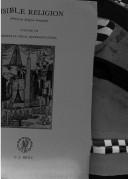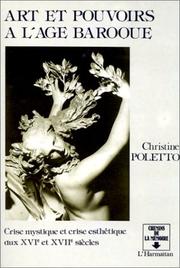| Listing 1 - 9 of 9 |
Sort by
|

ISBN: 9004090940 9004668659 Year: 1990 Publisher: Leiden Brill
Abstract | Keywords | Export | Availability | Bookmark
 Loading...
Loading...Choose an application
- Reference Manager
- EndNote
- RefWorks (Direct export to RefWorks)
Book
ISBN: 9004668659 Year: 1990 Publisher: Leiden, Netherlands : BRILL,
Abstract | Keywords | Export | Availability | Bookmark
 Loading...
Loading...Choose an application
- Reference Manager
- EndNote
- RefWorks (Direct export to RefWorks)
Multi
ISBN: 9781400860593 9780691603483 0691603480 1400860598 Year: 1990 Publisher: Princeton, New Jersey : Princeton University Press,
Abstract | Keywords | Export | Availability | Bookmark
 Loading...
Loading...Choose an application
- Reference Manager
- EndNote
- RefWorks (Direct export to RefWorks)
In this broad historical and critical overview based on a lifetime of scholarship, James Alfred Martin, Jr., examines the development of the concepts of beauty and holiness as employed in theories of aesthetics and of religion. The injunction in the Book of Psalms to "worship the Lord in the beauty of holiness" addressed a tradition that has comprehended holiness primarily in terms of ethical righteousness--a conception that has strongly influenced Western understandings of religion. As the author points out, however, the Greek forbears of Western thought, as well as many Eastern traditions, were and are more broadly concerned with the pursuit of beauty, truth, and goodness as ideals of human excellence, that is, with the "holiness of beauty." In this work Martin describes a philosophical stance that should prove to be most productive for the dialogue between aesthetics and religion.Beginning with the treatment of beauty and holiness in Hebrew, Greek, and classical Christian thought, the author traces the emergence of modern theories of aesthetics and religion in the Enlightenment. He then outlines the role of aesthetics in the theories of religion proposed by Otto, Eliade, van der Leeuw, and Tillich, in the cultural anthropology of Geertz, and in the thought of Santayana, Dewey, Whitehead, Heidegger, and Wittgenstein. In a global context Martin explores the relation of aesthetic theory to religious thought in the traditions of India, China, and Japan and concludes with reflections on the viability of modern aesthetic and religious theory in the light of contemporary cultural and methodological pluralism.Originally published in 1990.The Princeton Legacy Library uses the latest print-on-demand technology to again make available previously out-of-print books from the distinguished backlist of Princeton University Press. These editions preserve the original texts of these important books while presenting them in durable paperback and hardcover editions. The goal of the Princeton Legacy Library is to vastly increase access to the rich scholarly heritage found in the thousands of books published by Princeton University Press since its founding in 1905.
Philosophy --- Aesthetics --- Art and religion. --- Religious aspects.
Periodical
Year: 1990 Publisher: Firenze : Città Nuova,
Abstract | Keywords | Export | Availability | Bookmark
 Loading...
Loading...Choose an application
- Reference Manager
- EndNote
- RefWorks (Direct export to RefWorks)
Theology --- Art and religion --- Théologie --- Art et religion --- Catholic Church --- Église catholique --- Catholic Church. --- Italy.
Book
ISBN: 8870970124 9788870970128 Year: 1990 Volume: 9 Publisher: Roma : Quasar,
Abstract | Keywords | Export | Availability | Bookmark
 Loading...
Loading...Choose an application
- Reference Manager
- EndNote
- RefWorks (Direct export to RefWorks)
Art and religion --- Art et religion --- Rome --- Religion --- Religious life and customs --- Vie religieuse --- Religions antiques --- --Rome --- --Religions antiques --- --Art and religion --- Excavations (Archaeology) --- Etruscans --- Architecture, Etruscan --- Tombs --- Cerveteri (Italy) --- Antiquities.
Book
ISBN: 0824510364 Year: 1990 Publisher: New York : Crossroad,
Abstract | Keywords | Export | Availability | Bookmark
 Loading...
Loading...Choose an application
- Reference Manager
- EndNote
- RefWorks (Direct export to RefWorks)
Art and religion. --- Art --- Women in art. --- Art et religion --- Femmes dans l'art --- Themes, motives. --- Thèmes, motifs
Book
ISBN: 0691073570 9780691073576 0691603480 1322018502 1400860598 Year: 1990 Publisher: Princeton (N.J.): Princeton university press,
Abstract | Keywords | Export | Availability | Bookmark
 Loading...
Loading...Choose an application
- Reference Manager
- EndNote
- RefWorks (Direct export to RefWorks)
In this broad historical and critical overview based on a lifetime of scholarship, James Alfred Martin, Jr., examines the development of the concepts of beauty and holiness as employed in theories of aesthetics and of religion. The injunction in the Book of Psalms to "worship the Lord in the beauty of holiness" addressed a tradition that has comprehended holiness primarily in terms of ethical righteousness--a conception that has strongly influenced Western understandings of religion. As the author points out, however, the Greek forbears of Western thought, as well as many Eastern traditions, were and are more broadly concerned with the pursuit of beauty, truth, and goodness as ideals of human excellence, that is, with the "holiness of beauty." In this work Martin describes a philosophical stance that should prove to be most productive for the dialogue between aesthetics and religion.Beginning with the treatment of beauty and holiness in Hebrew, Greek, and classical Christian thought, the author traces the emergence of modern theories of aesthetics and religion in the Enlightenment. He then outlines the role of aesthetics in the theories of religion proposed by Otto, Eliade, van der Leeuw, and Tillich, in the cultural anthropology of Geertz, and in the thought of Santayana, Dewey, Whitehead, Heidegger, and Wittgenstein. In a global context Martin explores the relation of aesthetic theory to religious thought in the traditions of India, China, and Japan and concludes with reflections on the viability of modern aesthetic and religious theory in the light of contemporary cultural and methodological pluralism.Originally published in 1990.The Princeton Legacy Library uses the latest print-on-demand technology to again make available previously out-of-print books from the distinguished backlist of Princeton University Press. These editions preserve the original texts of these important books while presenting them in durable paperback and hardcover editions. The goal of the Princeton Legacy Library is to vastly increase access to the rich scholarly heritage found in the thousands of books published by Princeton University Press since its founding in 1905.
Aesthetics --- Art and religion. --- Religious aspects. --- Religious aspects --- Art and religion --- 21*01 --- 7.01 --- Art --- Arts in the church --- Religion and art --- Religion --- 7.01 Esthetica. Kunstfilosofie. Kunsttheorie. Algemene problemen inzake kunst --- Esthetica. Kunstfilosofie. Kunsttheorie. Algemene problemen inzake kunst --- 21*01 Godsdienstfilosofie: christelijke religie: filosofisch en rationeel --- Godsdienstfilosofie: christelijke religie: filosofisch en rationeel --- Radio broadcasting Aesthetics --- Aesthetics - Religious aspects.
Book
ISBN: 3201014885 9783201014885 Year: 1990 Volume: 9 Publisher: Graz: Akademische Druck- und Verlagsanstalt,
Abstract | Keywords | Export | Availability | Bookmark
 Loading...
Loading...Choose an application
- Reference Manager
- EndNote
- RefWorks (Direct export to RefWorks)
Christian drama in art. --- Art and religion. --- Christian art and symbolism --- Scene painting --- Italy --- Theater --- History --- Medieval, 500-1500 --- 16th century --- Theaters --- Stage-setting and scenery --- Painting [Medieval ] --- Painting [Renaissance ] --- Middle Ages, 500-1500 --- Christian art and symbolism - Medieval, 500-1500. --- Christian art and symbolism - Renaissance, 1450-1600.

ISBN: 2738404952 Year: 1990 Publisher: Paris : L'Harmattan,
Abstract | Keywords | Export | Availability | Bookmark
 Loading...
Loading...Choose an application
- Reference Manager
- EndNote
- RefWorks (Direct export to RefWorks)
Christian art and symbolism --- Counter-Reformation and art --- Reformation and art --- Art et symbolisme chrétiens --- Contre-Réforme et art --- Réforme (Christianisme) et art --- Art et symbolisme chrétiens --- Contre-Réforme et art --- Réforme (Christianisme) et art --- Counter-Reformation in art --- Art and the Reformation --- Art and religion
| Listing 1 - 9 of 9 |
Sort by
|

 Search
Search Feedback
Feedback About UniCat
About UniCat  Help
Help News
News